
b-qual news January 2025
15 min readFire, Flooding and Invasive Pests – Beekeeping Resilience in ‘The Lucky Country
A story of resilience and Determination
1400 beehives were destroyed by fire, then within a year another 700 to flooding, soon after that small hive beetle wiped out 500 more, and then close to another 1000 fell victim to the varroa mite incursion. In Grafton, northern NSW, Australia, Wayne Fuller and Janine Rudder have seen their beekeeping operation ravaged by Mother Nature and invasive parasites over the last six years. We get the grizzly details and learn how, with ongoing resilience, they are progressing their business to the next generation.
With approximately 4000 beehives and 600 sites, the Fuller family beekeeping business, Bee Services is a serious enterprise. Serious in its ability to provide for partners Wayne and Janine, Wayne’s brother Steven, Wayne’s two daughters and their partners, plus six more staff members and other labour-hire staff when required for extracting; but also serious in the nature of that work – generating an annual honey harvest of anywhere between 150 and 250 tonnes, pollinating vast areas of crops, and at times having to destroy their own hives for a proposed greater good.
In August last year, Fuller and Rudder attended The Beekeepers Conference in Whanganui, where Fuller took to the main stage to give a beekeeper’s perspective on small hive beetle. Following that, the couple sat down with Apiarist’s Advocate to provide greater insight into Bee Services, and the challenges which they have had to overcome in recent years.
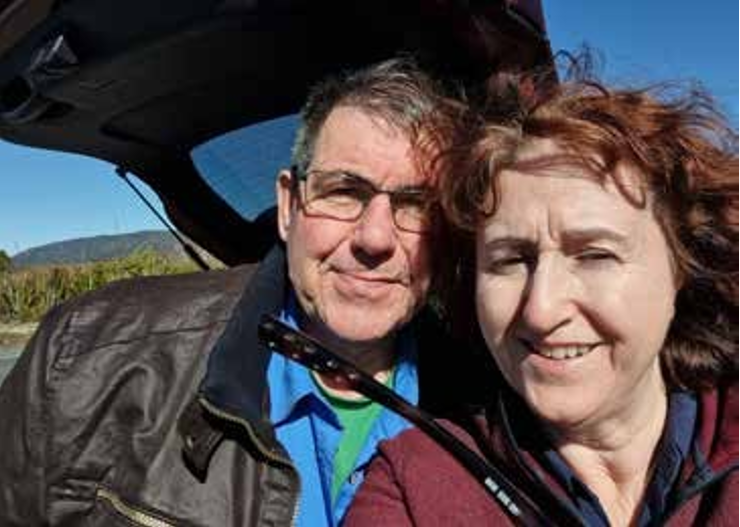
A family affair
Bee Services has long been “a family affair”, with Wayne at the helm for 45 years and Steven for 12 years. Now with Wayne’s daughters and their partners in the mix, along with wife Janine, the family connection is stronger still and it’s coming time for the next generation to take on a greater mantle. But, with Fuller still busy in the office and field and Rudder dedicating a lot of time to site management, handing over is a gradual process.
“Janine has told them she is retiring, and I have told them I will give them another year,” Fuller says.
“I don’t want to leave, but at the moment I am probably working 80 hours a week. I want to cut back, I need to cut back. First, I need to make sure the kids have a good year and I leave them in a good position.”
Despite working those long hours, Fuller says his physical abilities – especially his ability to lift heavy weights – are diminished following a cancer diagnosis in 2012 and the resulting treatment.
Plenty to do
Bee Services revenue is a near-even split between organic honey production and pollination contracts. Around 1000 of their 4000 hives are organic, supplying Australia honey behemoth Capilano. Honey varieties harvested include Ironbark, Spotted Gum, Bloodwood and other eucalypt species and hives can sometimes be on honey sites for just six weeks before they are moved off to chase the next flow.
The other 3000 hives work even harder, bouncing between pollination jobs and honey sites, making for plenty of hive movements – compounded by even more movements when fleeing bushfires.
About 2200 hives go from a six-month blueberry placement between February/March and August/September, then a stint in macadamia orchards for about six weeks in spring, before heading back to the blueberries for their summer crop for six more weeks, starting in December. Others hit the berry crops, with blueberries, raspberries and blackberries all receiving visits.
All that pollination work is a recent addition to the long-running business, with change coming about following that all too common Australian scourge – bushfire.
Diversity following destruction
In 2019 we were simply bulk honey producers, 250 tonnes of honey a year and then a bit of pollination for a neighbour,” Fuller explains.
“Then in the bush fires we had 1400 hives of bees burnt and lost all our floral resources. So, we swung over to pollination. That’s what we figured we had to do because we lost 80 per cent of our country.”
2019-20 has been dubbed ‘Black Summer’ in Australia, due to the wide-ranging fires which ravaged numerous states. That included New South Wales where, for nine months from July 2019 to March 2020, uncontrolled fires burned.
With their honey production sites being so remote, there was no chance of stopping the fire from reaching their hives.
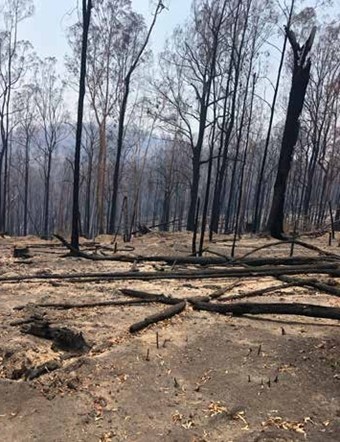
However, some hives were able to be rescued and relocated in a frantic few months where Fuller only stopped for sleep … and then only occasionally.
“Three months straight and barely any sleep,” he recalls.
In the end, it was Rudder who decided something had to change. “They were working all day, then moving hives every night, because fires would pop up everywhere,” she says.
“In the end I said to the guys, ‘you can’t keep doing this. You are going to have an accident, fall asleep at the wheel.’ I told them just to bring all the hives home.”
So that’s what they did. Between 600 and 700 hives in the backyard of their property and another 800-900 to their Grafton base.
“I remember calling a neighbour and saying, ‘be aware there is going to be a couple of truck and trailer loads of beehives coming home tonight and I don’t know whether you are going to get hit with bees or not tomorrow’,” Rudder says.
It was far from ideal – “you couldn’t walk outside the front door for the first few days because the bees were so disorientated”
– but at least they could see the hives, and get water to them quickly if needed.
It was more than a year after the last fire was put out until the bees were able to recover themselves, as they struggled to adapt to a charred landscape.
“The fires stopped in 2021 when it started raining, but the hives were still dying. You would put them out on site and the bees would go out and not come back,” Fuller remembers.
“I spoke to Liz Frost at the Department at Ag and she had seen it before in the Californian fires and said you need six generations of bees for them to get their directional sense back, so they can find where they are going to.”
When the rain comes… but doesn’t go
All up around 1400 hives were either directly or indirectly lost to the devastating fires of 2019-20. In a cruel twist of fate, more disaster awaited the NSW beekeepers though.
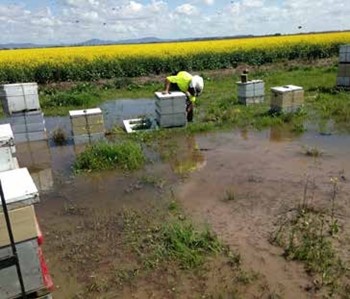
First 200 hives were swept away in flooding in 2021, then one of Australia’s worst recorded flood disasters struck Queensland and northern New South Wales in February 2022. Grafton, located on the floodplain of the Clarence River, was in the firing line again.
This time 500 Bee Services hives were inundated.
As if those four years of torment at the hands of Mother Nature were not enough to test their team, as the flood waters receded in 2022 a new foe was on their doorstep – small hive beetle.
‘Small’, but mighty destructive
“There were about 8000 hives washed away in the Lismore flood area and that created a massive hive beetle problem,” Fuller says.
“Even though we are 100km away, we were badly affected. The beetle will fly seven kilometres, but it will find a hive then hop to the next hive. It was looking for food because it had run out of food in its original area.”
Eventually they found food too, located in the beehives of their new domain. The result would be the loss of 500 more Bee Services hives to the invading beetle as it consumed honey and pollen, taking over the beehives and “sliming them out” with its faeces.
Yes, 2022 was a terrible year, but the team at the helm of Bee Services take a pragmatic approach.
“The way I looked at it was, OK we lost beehives, we lost all this, but we didn’t lose any lives. That was the only good I could look at coming out of it,” Rudder says.
Having had several seasons to learn to manage the beetle, Fuller says it is not all that big of a concern, while noting other beekeepers might disagree with that assessment.
“You just have to stay on top of it. As long as you don’t underestimate it, it is no different from American foulbrood (AFB). If you don’t take AFB out, it will take you out.”
Varroa’s turn
Witnessing Mother Nature, or an invasive pest, wreak havoc with your livestock is one thing, but having humans inflict the destruction is another challenge altogether and in June 2022, the very same year small hive beetle and flooding were having
their way with Bee Services, varroa was detected 470km south in Newcastle. Then in July much closer, Nana Glen 60km away.
Rudder says they were mentally exhausted before varroa was found in NSW and news of its arrival “was just devastating”.
However, Fuller is circumspect.
“We always accepted the fact we were going to get varroa and so when we did, it was no surprise,” he says.
“The timing could have been better though” Rudder points out. “Another year, another honey flow, would have been good. But it
is what it is.”
And again, the destruction was vast, as the industry undertook to eradicate the invader through euthanasia of infected, or nearby, colonies – an ultimately unsuccessful measure as the ectoparasite now moves across the county.
Fuller says 160 of their hives were killed because they sat inside an eradication zone. Another 1000 were in a surveillance zone and they were offered a cash payout to destroy them. With pollination contracts to fill and having already witnessed so many of his bees killed, Fuller decided not to take the cheque.
That was a one-million-dollar mistake.
Continuous working and sampling of the bees left most of those colonies dead or near-dead, even though no varroa mites were found in the process.
“We agreed to keep monitoring for mites, not to move them, to keep feeding sugar as required, whatever we needed to do to keep them alive, because they were pollination hives. They would continually do surveillance on them though, sometimes three times a week, because one hand of the response wasn’t talking to the other and they were looking for things to do,” he says.
The response has now turned from one of eradication to management and at Bee Services that has meant varroa training for all the staff and selling a lot of equipment – including more than half a million dollars’ worth of trucks – to get cashed up.
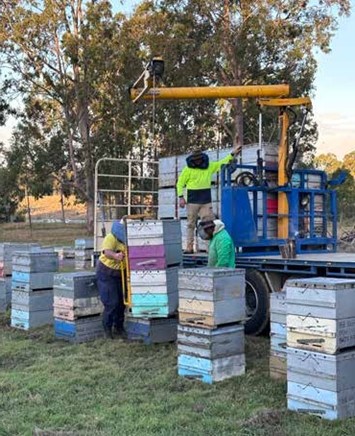
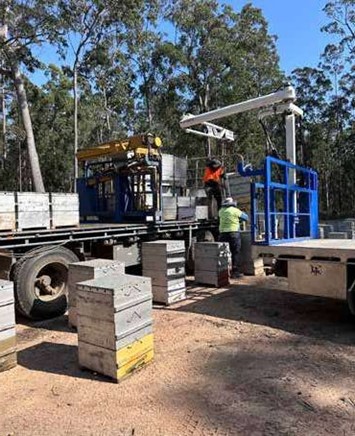
“The business plan was to get leaner so that we have the resources behind us to get through. We planned on having a bad time, which is what you have to do sometimes. You have to be ahead of the game to survive. And it is about survival mode for a lot of beekeepers,” Rudder says.
Survival mode
Survival mode continues as the calendar turns to 2025, but the challenges faced down between 2019 and 2023 were surely enough to defeat many a person’s mind, body or business. Despite them, the business continues and they are welcoming a new generation into the fold.
Some have struggled, including Wayne’s brother Steve who suffered a stress-induced stroke amidst the pandemonium of the bush fires. He has recovered and returned to work, but some staff have not. The scene which greeted them on their return to fire ravaged environments have been particularly challenging.
“Steve walked in to a site and said the screams from the animals were eerie. We had one young fella who had been with us for four years who, after seeing what he saw, didn’t want to go back. He finished beekeeping,” Fuller says.
“Normally the bush is alive, birds squawking, possums fighting, but then it was quiet, except for the screams of animals in distress. I never want to go back to that.”
They have not been alone in their setbacks though, and helping other beekeepers motivates them.
“There were beekeepers on suicide watch, but generally the beekeeping community, especially amongst the older guys, is very tight. I definitely noticed the amount of phone calls they were making, just to check up on each other,” Rudder says of the varroa elimination period.
“There are times where you could just about sit down and cry, but you would keep on going,” Fuller admits of his own challenges through the worst of it.
“We like to keep an eye out for other beekeepers as well.”
Despite their setbacks, due to the size of their business and the success they have at times had, Fuller says others have been, astonishingly, known to comment on their good luck.
“People keep telling you how lucky you are, but it is not luck. It is 40 years of hard work. I tell people who ask, ‘keep working on it’. We have a monthly plan, a six-monthly plan, and so on,” he says.
Those plans are made in family business meetings, where conversation is frank and to the point, but can still take a full day, such is the level of detail.
“The kids came back into the business after five bad years and varroa has just hit. We are hopeful though,” Rudder says.
“The kids and their partners had high-paying jobs and if they didn’t see a future in beekeeping, they would not have left those jobs,” Fuller says, adding “There is definitely hope at the other end.”
A note from Wayne and Janine: It is worth noting that beekeeper problems are the same wherever we go, and detailed record-keeping is the key to survival.
[This article first appeared in New Zealand beekeeping eMagazine and website Apiarist’s Advocate.]
Lindsay Bourke Awarded Life Membership to B-QUAL Australia
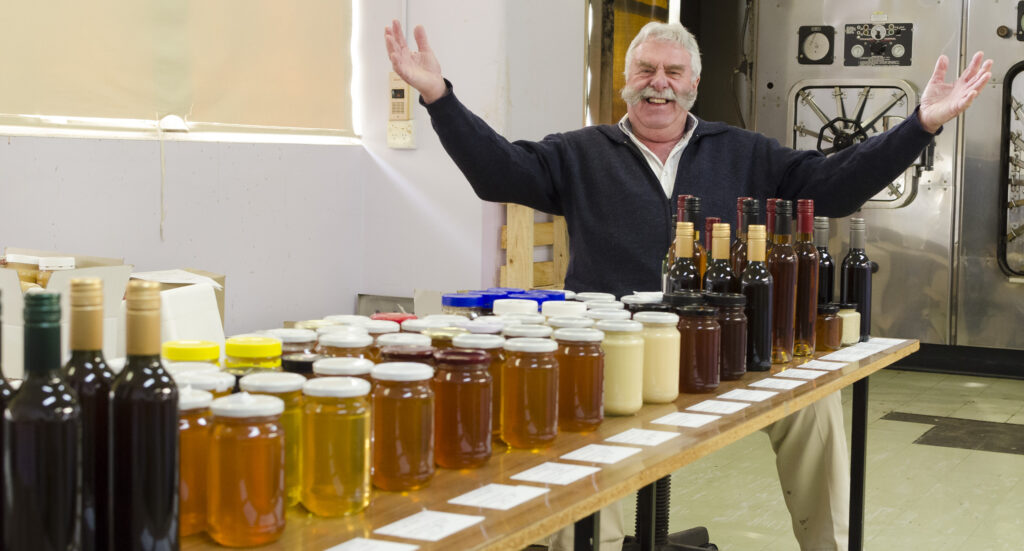
Lindsay Bourke is a lifelong Tasmanian who commenced beekeeping in 1966. After leaving school, Lindsay became a wool classer. His interest in beekeeping saw him leave the wool industry after 11 years to become a fireman.
This gave him the opportunity to build up his hives and turn his passion for beekeeping into a reputable honey business, Riverside Apiaries, which continued for nearly 20 years. During the period Lindsay purchased a house or flats every year from his beekeeping proceeds.
Lindsay’s enthusiasm for challenges saw him leave the honey business in 1980 when other interests, including extensive property development, took hold. In addition to owning and managing 74 residential properties, Lindsay ran restaurants, hotels and motels and renovated many of Launceston’s historic buildings. Lindsay was a board member of the Australian hotel chain Flag Hotels International and an inaugural board member of Flag Choice Hotels. Choice Hotels America are the second-largest hotel chain in the world. They eventually purchased Flag Choice Hotels. During Lindsay’s ten years as a board member, he was on the audit committee.
His passion for beekeeping returned in 2002 and he made Australian Honey Products an award-winning venture exporting to countries such as Korea, Japan, Tahiti, Germany, Jordan, Malaysia, Indonesia, China, Singapore and the United Kingdom. In 2007 the company received the Tasmanian Regional Exporter of the Year Award.
Between 2002 and 2010, Australian Honey Products won Gold six out of eight years for the World’s Best Leatherwood Honey at the annual conferences of the Tasmanian Beekeepers Association. The company had become famous for its Cradle Mountain Leatherwood Honey, which is symbolic of the Tasmanian wilderness.
The company now boasts three Brands, the original Cradle Mountain Honey, Taverner’s Boutique Brewery and Sheffield Honey Farm. Lindsay’s company manages 3000 + hives and produced 1% of Australia’s honey production in 2010.
Lindsay is an active campaigner and advocate for the beekeeping industry and is currently and, or in the past, has been a member of virtually all industry committees/portfolios within this industry.
These include:
- Serving four terms as AHBIC Chairperson
- The AHBIC Food Safety and Residue committee
- Member of AHBIC representing the pollination industry
- Serving 5 years on the Disease Quarantine committee
- Pollination Australia Industry Alliance
- Pollination advisory committee
- RIRDC and HAL member of Animal Health Australia
- Member consultative committee of Emergency Animal Diseases.
- Consultative member of Emergency Plant Health committee
- Member of the National Management Group
- President (current) Tasmanian Beekeepers Association.
Lindsay has been for many years a driving force in the development of B-QUAL; both during his 7 years on the Board and over later years has been a respected source of wisdom and advice to B-QUAL. Lindsay has always given his time willingly to B-QUAL whenever consulted.
The current B-QUAL board unanimously supports this life membership award.
Minimising RISK with Fair Work and WorkSafe Claims against your Business
Every business in the country reports to at least 3 regulatory authorities:
- The ATO.
- Fair Work and
- WorkSafe.
The ATO is the easy one. The Accountant puts it in place and we follow the bouncing ball.
Fairwork and WorkSafe are the hard ones. With contains changes, the requirement for Policy, Process and Proof, it represents SUBSTANTIAL RISK for Business Owners.
If you would not dream of having an Accountant when these two regulatory authorities are the hard one, it is important to GET SUPPORT!!
Getting support
Considering the ever-changing HR and OH&S landscapes, it is important for Business Owners and Operators to stay ahead of the curve and understand the impact of legislative changes upon their business. It is also a statutory obligation for all businesses to have a compliant OH&S system.
It is our intention to both proactively and strategically protect the business owners and operators regarding HR and OH&S. It is important for us to assist our members in having the relevant Policy, Process and Proof to facilitate this.
That is why we work with you 24/7/365. It is also our intention that these systems assist with enhancing the return on investment form your labour fixed costs, which I personally feel more than covers the cost for this compliance.
We are here to take work off your table and provide you with the peace of mind and confidence that you are supported and protected as both a business and an individual.
We provide peace-of-mind and confidence.
Peninsula is “NOT” a Government organisation. We are a proudly independent company helping Business Owners proactively and strategically protect their businesses regarding HR and OH&S.
Let us take the load.
Peninsula will work with you to navigate and manage confusing workplace requirements. We are here to support YOU.
How does it work?
By advising, assisting and supplying robust Policy, Process and Proof, (record keeping systems).
We take a huge administrative component from your business. By customising and providing employment documentation including contracts, employee handbooks, employee letters and correspondence, performance management and disciplinary materials and a variety of other bespoke materials.
By providing 24/7 advice and support in relation to FairWork and Work Safe legislation, compliance, managing employment relations matters and holding difficult conversations. In fact, anything to do with Employment Relations and Work Health and Safety.
Providing access to our Award-Winning Legal Partner for legal representation.
Safeguarding our clients against the financial costs of workplace claims. This is subject to the terms and conditions of the attached PDS.
PLUS our BrightSafe and BrightHR Software Solutions, which can help you get on top of Work Health and Safety compliance, rostering, leave management, expense management and document management.
Additional resources for review
Please take a moment to view this short video clip.
Please also click on the following link for Trustpilot reviews. We have an excellent 4.8 stars out of five across over 1800 reviews.
https://au.trustpilot.com/review/employsure.com.au
With over 31,000 clients just like you, Peninsula is a brand you can trust at a price you can afford.
Get in touch for details and to sign up
Office: Phone: 07 4994 9820
B-QUAL email: admin@bqual.com.au
B-TRACE email: admin@btrace.com.au
Join B-TRACE QA and Food Safety Program:
“Accurate record-keeping is the backbone of a successful food safety program.”
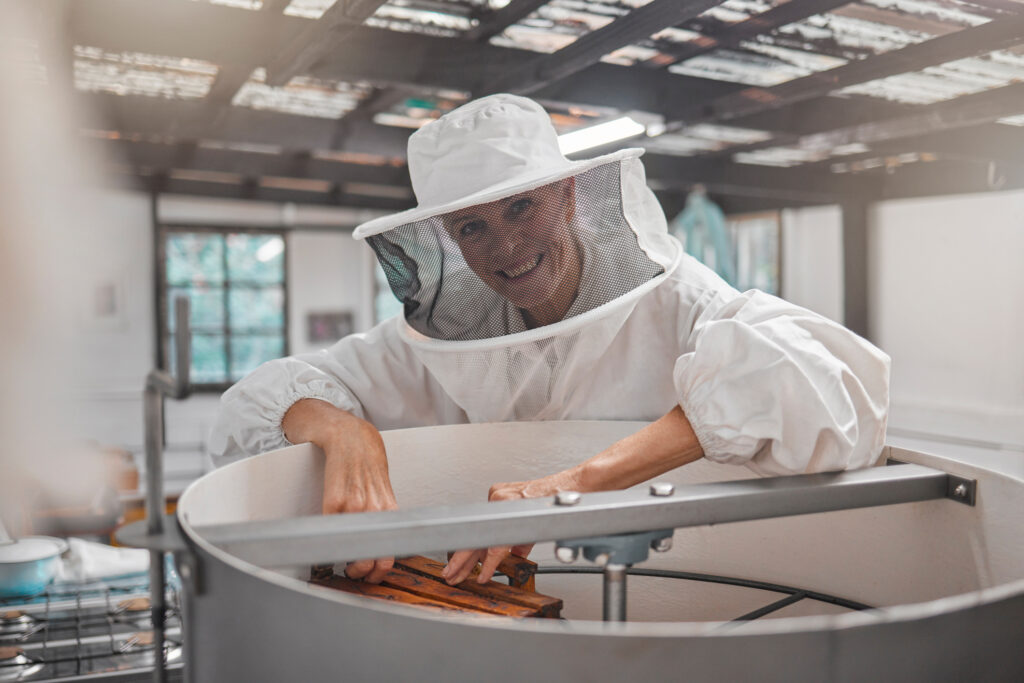
Food safety is crucial for maintaining health standards and ensuring that food doesn’t cause harm to consumers. One vital aspect that everyone involved in food production, from farmers, food manufacturers, and beekeepers must focus on is strict record keeping. Joining the B-TRACE QA and Food Safety Program is one way to help achieve this goal and enhance food safety practices by using the B-TRACE hive management app.
The B-TRACE program encourages small and medium enterprise beekeeping operators to put reliable, systematic practices in place to ensure that all aspects of food safety are handled correctly.
What is B-TRACE?
B-TRACE could stand for “Building Traceability Assurance for Compliance and Excellence.” The program is designed to equip beekeepers with the tools and knowledge they need to ensure food safety from apiary to consumer.
The primary aim of B-TRACE is to enable operators to track and monitor every aspect of honey production. This includes gathering, processing, packaging, and distribution. Keeping accurate records allows businesses to pinpoint any problematic areas before they lead to significant issues.
Why Join B-TRACE?
There are several reasons why being a part of the B-TRACE QA and Food Safety Program is beneficial:
1. Enhanced Safety Standards:
By joining B-TRACE, you align your practices with industry standards that emphasize food safety and quality.
2. Improved Traceability:
With the use of the B-TRACE hive management app, you can easily trace products. This is critical in the event of a food recall.
3. Better Consumer Confidence:
When customers know that a company is dedicated to safety, they are more likely to trust its products.
4. Regulatory Compliance:
Participating in B-TRACE helps ensure that your organization meets all industry standards and requirements for food safety and record keeping.
Statistics show that businesses with strong record-keeping are less likely to experience safety violations. Keeping accurate records allows companies to identify trends and improve their safety protocols effectively. As part of B-TRACE, you will have access to templates and software designed to simplify this process.
Benefits of Effective Record Keeping
1. Liability Protection:
In case of illness reports or food recalls, having excellent records can protect your business legally.
2. Operational Efficiency:
When everything is documented, it becomes easier and quicker to find crucial information, thereby allowing for better decision-making.
3. Employee Training:
Records provide a history of incidents and safety measures. They are valuable tools for training employees on food safety practices.
4. Quality Control:
Systematic record keeping can help identify areas for quality improvement.
Make the move now contact BTRACE via www.btrace.com.au or phone 07 4994 9820

Notices
B-TRACE Audits.
If you have not yet submitted your online audit for the current year, please do so to keep your accreditation up to date.
The online audit form is available in the member section of the B-TRACE website or alternatively, contact admin@btrace.com.au and we will email one to you.
Once completed email back to the office.
Allow 5-7 days for audit review and issue of the accreditation certificate.
B-QUAL and/or B-TRACE logos.
Pre-printed logo labels are available from the office.
B-TRACE 30mm lid labels full colour
$26.50/1000 (plus GST and postage)
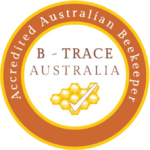
B-QUAL 12mm jar labels full colour
$ 22.50/1000 (plus GST and postage)
If you are printing your own labels high Res’ artwork is available free of charge.
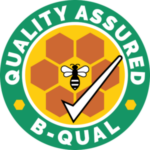
B-QUAL Self Assessments.
If you have purchased your Approved Supplier Manual but have not yet submitted the self-assessments, you cannot proceed with further certification until self-assessments are submitted.
The assessments are in the first section of the manual. Complete both assessments and send them to admin@bqual.com.au for review and certificate issue.
If you have any queries about assessments contact admin@bqual.com.au for further assistance.
Members section of websites.
To access the member section of the B-QUAL and B-TRACE websites you need to create an account.
To do this email the office requesting an account for either website.
Once the account is set you will receive an email requesting to log in and change the initial password. Remember that you must have a separate account for the members section, your app or other passwords will not work.
Our Sponsors:
We acknowledge and thank Steritech and the CMV Group for their valuable ongoing support of B-QUAL and B-TRACE which assists us to continue to participate in research and industry development works that we see as important to our industry.

Please support those who support us.
Contact details
General enquiries for B-QUAL & B-TRACE:
Office: All enquiries. Phone: 07 4994 9820
B-QUAL email: admin@bqual.com.au
B-TRACE email: admin@btrace.com.au
Newsletter disclaimer:
Material and information published in the B-QUAL newsletter are produced for general information only. Although published in good faith, the company and/or any officer of the company will not be liable for any loss suffered by any person for action taken on the basis of such information.
